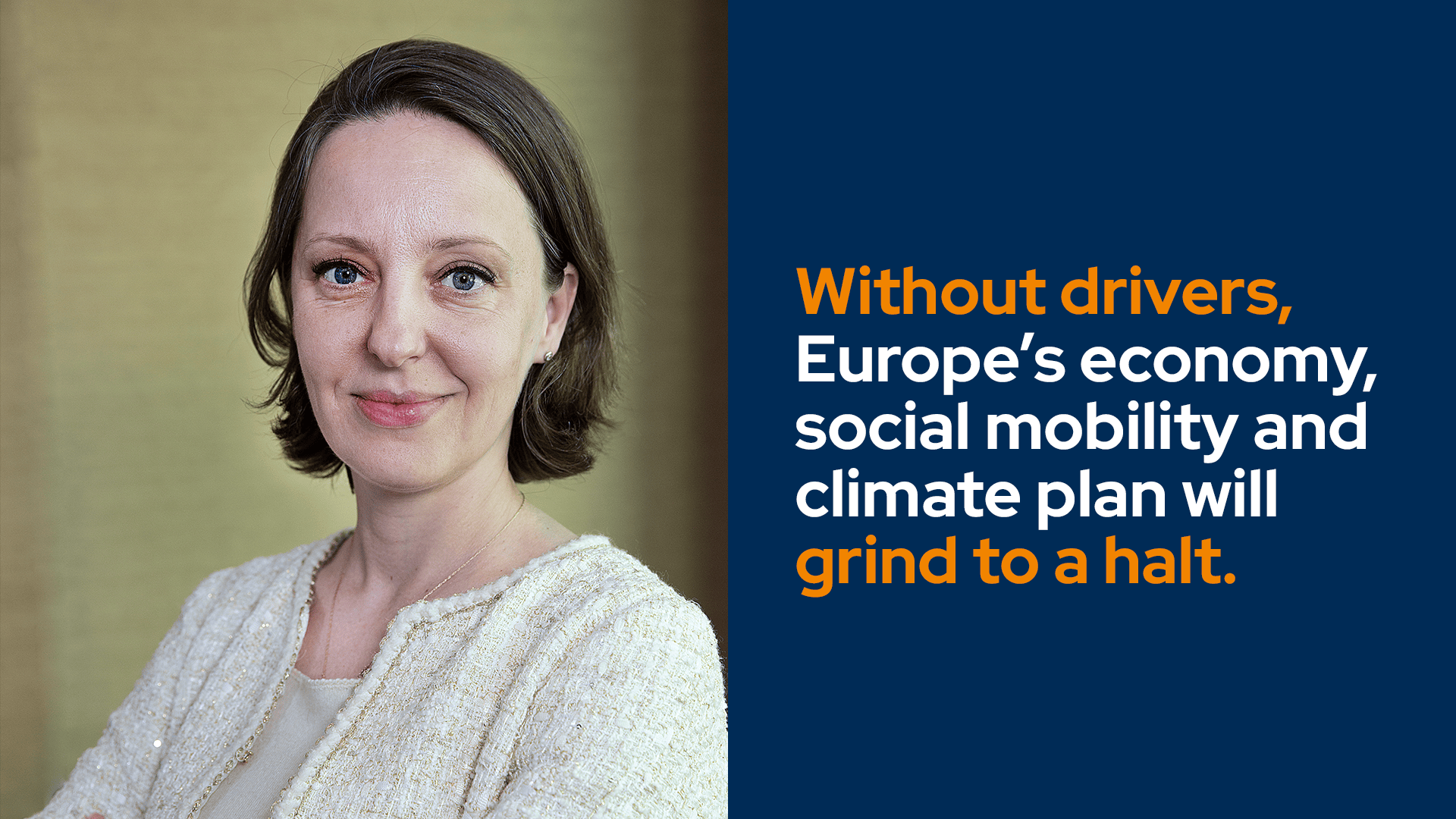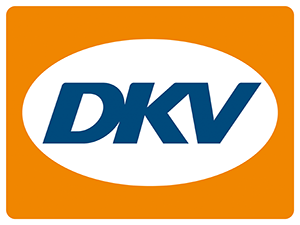Turning the corner: Addressing the issue of driver shortages in Europe

In this exclusive interview with Raluca Marian (Director of EU Advocacy at IRU) we delve into the topic of driver shortages across Europe.
Raluca provides a glimpse into the work of IRU, the voice of the global road transport industry. With 176 members across 80 countries, including multinational companies and national associations, IRU represents over 3.5 million road transport operators. Their mission is to shape industry policies in a realistic way, enabling the transport sector to thrive and benefit communities and economies worldwide.
The discussion looks into the severity of driver shortages in Europe but also outlines how the issue can be solved if policymakers and industry players work together with purpose.
Newsroom: About the IRU - tell us a bit about the organisation: What do you do? Who do you represent? Where are you active?
Raluca Marian: IRU - which was founded 75 years ago in Geneva, Switzerland - is the voice of the global road transport industry. Via our 176 members, which include national associations in 80 countries and multinational companies, we represent over 3.5 million road transport operators, with 1 million in the EU alone.
Together with our members, ranging from bus, coach, taxi and truck operators to providers of premium road transport services, we strive to shape industry policies in a realistic way, enabling our sector to thrive in the interest of communities and economies worldwide.
Our Brussels office, which was founded 50 years ago on 1 July 1973, focuses on policy-making at EU level, ensuring the voice of transport companies is heard loud and clear. Our EU advocacy work centres around helping the bloc reach its emission reduction objectives with the “Fit for 55” package and the IRU’s Green Compact, as well as the implementation of the EU’s Mobility Package and improving drivers’ working conditions.
Newsroom: Could you provide some background information on the issue of driver shortages in Europe? How severe is the problem? If the trend continues, what is the outlook for European road transport?
Raluca Marian: It's not been looking good for years, but with an ageing driver population, it's getting more worrying every year. Without action to make the profession more accessible and attractive, Europe could lack over 2 million drivers by 2026, impacting half of all freight movements and millions of passenger journeys. This is putting already stressed economies and communities at higher risk of inflation and could seriously impede supply chains.
In Europe, driver shortages jumped by 42% from 2020 to 2021. Vacant driver positions reached 71,000 in Romania, 80,000 in both Poland and Germany, and 100,000 in the U.K. In other countries, chronic commercial driver shortages are getting worse, with many positions unfilled.
The industry is facing a demographic time bomb; young drivers under 25 remain a small minority. In Europe, only 3% of bus and coach drivers are under 25, half the rate of the overall transport sector which stands at 7%. Drivers over 55 constitute 32% of the workforce, with an average driver age of 50. The EU will have around 500,000 vacant driver positions by the end of 2023, a truly wasted opportunity given the 14.5% youth unemployment rate.
But solutions are available. We must do everything we can to prevent forecasts, such as the one for 2026, from materialising.

Newsroom: How can the issue of driver shortages potentially be solved? What are policy options available? What has the IRU done to promote these solutions?
Raluca Marian: The urgency of the situation is clear. We cannot continue down this path. It will lead us down a very dark road. Nevertheless, it’s encouraging to see how seriously the sector is pursuing solutions, as well as the support from EU parliamentarians and authorities.
In October 2022, our Dinner Dialogue in the European Parliament brought together the road transport sector and public authorities to explore solutions to driver shortages. The emphasis was put on removing barriers to entry for young people, improving working conditions, and mobilising automation as an opportunity to boost the industry’s image.
We're also pushing the EU to use the ongoing revision of the Driving Licence Directive to lower and harmonise the minimum driving age across the EU, including for passenger transport, as well as to allow young people to start their professional driver training at 17. IRU has put forward a full set of proposals for the revision of the EU Driving Licence Directive to reduce driver shortages in the EU, including by reducing the school-to-wheel gap and harmonising conditions to integrate third-country drivers into the EU workforce.
By endorsing the industry’s proposals, it is expected that the current share of young drivers below 25 years (6% for freight and 5% for passenger transport) would increase to 10% by 2030, placing the road transport industry on a solid, long-term rejuvenation path. The sector also aims to increase the share of women drivers from 3% to 10%.
IRU is also one of the driving forces behind the European Commission’s proposal to co-fund the building and upgrading of safe and secure truck parking areas in Europe, with a record amount of 750 million € invested from 2021 to 2023. We are now in the third year, but we see that the EU funding is not being used efficiently by the beneficiaries. And it is real a pity, because with such funds, supported by an equal amount of private investment, some 60,000 to 70,000 additional safe and secure parking places could be created in Europe, which is ten times more than the current number.
We must join forces with our partners to redress this situation, since the lack of safe and secure parking places has been one of the biggest driver complaints, contributing directly to the shortage of drivers. On 7 April 2022, the European Commission adopted new EU standards and procedures to support the development of a network of safe and secure parking areas throughout the EU. The initiative is intended to improve resting conditions for drivers, and to protect them from violence and cargo crime.
While IRU welcomes the adoption of the regulation, a lack of safe and secure parking areas continues to be a major problem for the European road transport sector. With only 300,000 parking places currently available in the EU, there is a significant shortfall of 100,000 to meet total demand.
According to a 2019 study, only about 7,000, less than 3%, of existing parking places in the EU, are in areas certified to be safe and secure. While the number of safe and secure parking areas has slightly increased since 2019, IRU continues to urge policymakers to provide additional support to improve conditions in the sector by advocating for EU-funding to build new, and upgrade existing, safe, and secure parking areas.
Newsroom: How have the potential solutions proposed been received by policymakers at EU and national level? Has anything been done? Are any countries leading the way? Are there any bottlenecks?
Raluca Marian: It’s been a mixed bag.
The main opportunity here is the European Commission’s proposal to renew the Driving Licence Directive. It has many promising aspects that can address the chronic shortage of drivers in the goods transport sector. But it falls completely short when it comes to passenger mobility, but also to address the industry’s proposals regarding the minimum age of professional drivers.
IRU has therefore made proposals to legislators to redress the situation and set the minimum age of truck drivers at 18, as a main rule, while at the same time making proposals for passenger transport, starting with removing the distance limitation of 50 kilometres in the EU Driving Licence Directive and the mutual recognition of Member State derogations allowing bus and coach drivers below 21 to drive.
We are now expecting a proposal from the Commission to allow some specific derogations for driving and rest times for coach tourism drivers, something we have wanted for years. Any movement to make them adapted to the specificity of coach tourism drivers is welcomed by IRU and will be supported in the European Parliament and Council.
Newsroom: Do you have any words of advice for European road transport companies grappling with shortages? What can they do to minimise the impact of this issue?
Raluca Marian: Road transport operators are already doing their best to improve access to the profession and boost its appeal, despite often running on razor thin margins. It’s really up to the EU and governments to take significant action. The ball is in their court.
As we all know, high licence and training costs are major obstacles to new people joining the industry. In France, a truck licence costs 5,300 €, which is more than three times the average minimum monthly salary. In Germany, a bus and coach licence costs 9,000 € on average, over four times the minimum monthly salary. Any programme or training that helps to cover some of these costs can help transport companies to attract more drivers.
Improving security, particularly for women drivers, is crucial to making the profession more attractive, with 95% of truck drivers and 94% of transport companies ranking it as their top priority. But again, there is only so much that transport companies can do, as only 3% of existing EU truck parking places are certified as safe and secure.
Newsroom: Do you think this will be a long-term systemic issue for European road transport or is it a temporary problem?
Raluca Marian: Without drivers, Europe’s economy, social mobility and climate plan will grind to a halt. But there are proven solutions, especially if industry and government work together.
The shortage of drivers is a problem that started many years ago and will probably stay with us for quite some time. It has become structural and involves the entire industry. IRU has a strategy to, first, slow down the increase of driver shortages, and then to reverse the trend.
One of the key short-term solutions is to recruit qualified third-country drivers (i.e., from outside the EU). They are already trained, have a professional record, and can easily be introduced into the EU market with appropriate and targeted training. Together with our European partners, we have advanced proposals to create a genuine EU legal framework for introducing them into the EU market.
In the longer term, and this is our main strategic objective, we need to make the profession more appealing to women and young drivers. This would require adapting the minimum driving age to close the school-to-wheel gap, building more safe and secure parking places, and improving working conditions. The technological revolution that is happening within the cabin and the access to new apps will also facilitate the driving experience and appeal to younger drivers.
Newsroom: Could autonomous vehicles offer a solution to the problem?
Raluca Marian: Not in the short or medium term. The job might change, but autonomous vehicles will still need to be managed. To do so, a professional driving licence will still be necessary. Drivers will not become superfluous, at least not for the next 15 to 20 years.
The sector will need a clear vision for its future workforce. Transport workers and operators must be properly trained and ready for new digital challenges. A connection between new technological developments and labour law and specific, flexible conditions for drivers should be established, as well as skilling and reskilling programmes.
Governments need to provide real business incentives to expedite the penetration of the latest technologies and best practices. Policies encouraging the use of collective passenger transport and freight delivery are needed to promote the efficient use of scarce public space and prevent autonomous vehicle congestion.
We hope that the massive technological development represented by autonomous vehicles will make the sector more appealing to young people and women.
Footnote: IRU Intelligence Briefing - Driver Shortage Global Report 2022, June 2022
